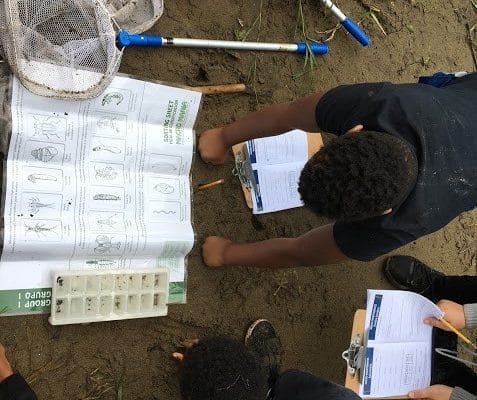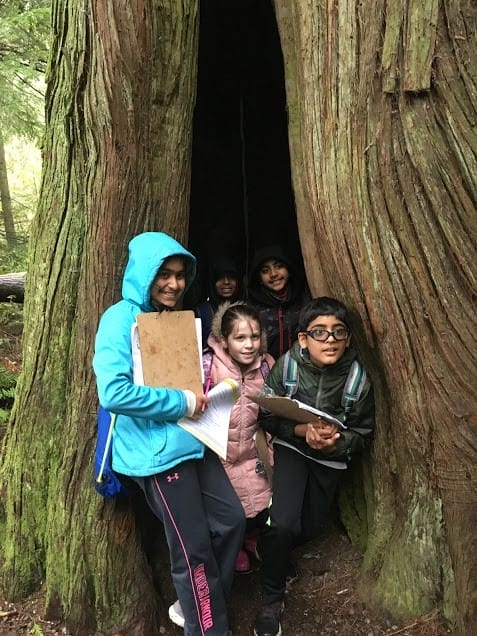Lessons from Tiger Mountain
Just off exit 20 on Interstate-90, a Tiger sleeps. And on a cold-wet day in fall, students stand in a circle at the base of the Tiger’s tail, listening to the sounds that fill the forest. I smile at the silent mouths, closed eyes, and attentive ears of the students. “We hear the sound of the wind,” one student says. “I think I heard a frog!” says another. This was the first time all afternoon that all 25 students were completely connected with their surroundings; huddled in a tight circle on a Tiger’s tail, but in a world of their own as they consume and reflect on nature’s melodic sounds.
During the fall and spring, the education team at the Mountains to Sound Greenway Trust brings thousands of students out to Tiger Mountain in Issaquah. Most of these students come from the western region of the Greenway (Greater Seattle and Snoqualmie area). Some have grown up exploring the Issaquah Alps, while others tell us that this is their first time out in nature. Access to the outdoors is being redefined through environmental education. For more than two decades, the Greenway Education Program has connected at least 3,000 students every year with nature. Of those students, more than 50% come from schools with at least a 50% free and reduced lunch rate. (The free and reduced lunch rate is one way we identify low-income schools). An equitable opportunity for environmental education is needed, and the Greenway hopes to provide those experiences for youth throughout the Greenway landscape. Place-based learning gives students the chance to not only learn about the environment but allows them to form a long-lasting relationship with it. The goal of the Greenway Trust is to connect people with nature, and that is what the Education Program does.
Environmental education produces many benefits for students and the larger community. When I am on the trail with students, I see a shift in them from when I first saw them in our in-class lessons: their awareness and mental presence are made clearer and more profound. The studies of environmental education on health are wide and informative; they have shown the positive impacts of environmental education on people with ADHD, depression, obesity, asthma, diabetes, and more. We can observe these physical health changes along with an increase in mental, social, and spiritual well-being.

Education in the outdoors positively affects both the individual and the greater community; environmental education helps create smarter learners and innovative leaders:
Through the Greenway curriculum, students are challenged with questions about our declining ecosystems and humans’ relationship with nature. They use critical thinking skills, problem-solving, and cooperative learning. By tackling long-term, real-world issues such as environmental degradation, they develop skills that allow them to make a critical decision and become innovative leaders. Environmental education also provides a more equitable learning space. Not all students learn the same way: environmental education provides the opportunity to encompass the seven styles of learning–visual, aural, verbal, physical, logical, social, and solitary–into one curriculum. This allows for all students to excel, leading to more confidence in school.

By giving students the equitable tools to be critical thinkers and innovate learning, they can be curious and compassionate leaders of tomorrow:
Curriculum needs to provide more space for critical thinking and problem solving because those are necessary skills to make informed decisions. When practicing those skills through environmental education, students make connections about what they are learning in the (outdoor) classroom to their real life. When they make connections with nature, they can share that with family and friends in a real and profound way by bringing them out into nature, too. The partnership between student and environment is the bridge to a new generation of curious and compassionate leaders.
During that rainy day in fall, 25 students took a moment to observe and reflect. They began their day with reservations and curious mind and ended their time with a new perspective on what learning can look like. Seeing students exploring curiously and with excitement is the beginning of the relationship that we hope environmental education can be the catalyst of.
The youth of this generation are intelligent, brave, innovative, compassionate, and more aware than any other generation before them. They are the ones who will guide future conservation with a passionate perspective of knowledge and empathy. Environmental education gives them the opportunity to learn not only about nature but about their community, both on a local and on a worldly scale. It creates curious and compassionate stewards of the earth who will soon be the future decision-makers world. It is important to equip the youth with tools and knowledge to make those decisions with nature and community in mind.
“Schools have the unique opportunity to encourage active and healthy lifestyles in children and adolescents by transforming school grounds to natural playscapes that offer the physical and psychological benefits of outdoor play and access to green environments.” (NEEF)

Sources:
- “Benefits of Environmental Education.” National Environmental Education Foundation, www.neefusa.org/nature/water/benefits-environmental-education.
- Grimmette, Katherine A., “The Impacts of Environmental Education on Youth and their Environmental Awareness” (2014). Environmental Studies Undergraduate Student Theses. 135. http://digitalcommons.unl.edu/envstudtheses/135





